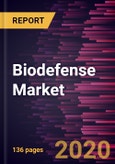Favorable government initiatives, increase in the number of naturally occurring outbreaks, and increasing threat of biological weapons and nuclear armed ICBM are some of the major factors driving the growth of global biodefense market. However, low government R&D funding in developing and underdeveloped economies is expected to restraint the growth of the market during the forecast period.
Disease outbreaks are usually caused by an infection transmitted through person-to-person contact, animal-to-person contact, or from the environment. The emergence of infectious diseases has increased significantly during the recent years. The World Health Organization warned in its 2007 report that infectious diseases are emerging at a high rate across the world. Since 1970, about 40 infectious diseases have been discovered, including SARS, MERS, Ebola, chikungunya, avian flu, swine flu, zika, and most recently, COVID-19. According to the estimation of Centers of Disease Control and Prevention (CDC,) in the US, nearly 30 million people suffered from influenza between 2016 and 2017. Biodefense techniques, such as vaccinations against influenza help reduce the illness by 17% and medical visits and hospitalizations by 18% and 19%, respectively. The growing prevalence of Ebola and Zika virus infections is also likely to contribute to the market growth. For instance, according to the CDC, as of November 2015, over 28,000 Ebola virus cases and more than 3,800 deaths because of Ebola virus were reported in Guinea. Additionally, due to coronavirus outbreak, more than 210,000 cases have been reported to WHO, and more than 9,000 people have lost their lives till March 20, 2020. Further, on March 18, 2020 Emergent BioSolutions signed a development and manufacturing agreement with Vaxart for their oral vaccine experiment on infected candidate for Coronavirus Disease. The growing prevalence of infectious diseases, such as coronavirus, Ebola, and zika virus is likely to boost the investments in the field of biodefense, thereby driving the market growth.
The global biodefense market is segmented into product and geography. Based on product, the biodefense market is segmented into anthrax, small pox, botulism, radiation/nuclear and others. The anthrax segment accounted for the largest market share in 2019. The anthrax segment is expected to continue its dominance during the forecast period owing to increasing funding by the governments of other countries to develop and stockpile adequate vaccines against anthrax mainly through a variety of initiatives, such as BioShield Act, Biomedical Advanced Research and Development Authority (BARDA), and the Joint Program Executive Office for Chemical & Biological Defense.
Food and Drug Administration, World Health Organization (WHO), Organisation for Economic Co-operation and Development, Socio-Economic Contribution of the European Cosmetics Industry (SECECI), and Emirates Standardization and Meteorological Authority (ESMA) are some of the essential secondary sources included in the report.
Reasons to Buy:
- Save and reduce time carrying out entry-level research by identifying the growth, size, leading players and segments in the biodefense market.
- Highlights key business priorities in order to assist companies to realign their business strategies.
- The key findings and recommendations highlight crucial progressive industry trends in the global biodefense market, thereby allowing players across the value chain to develop effective long-term strategies.
- Develop/modify business expansion plans by using substantial growth offering developed and emerging markets.
- Scrutinize in-depth global market trends and outlook coupled with the factors driving the market, as well as those hindering it.
- Enhance the decision-making process by understanding the strategies that underpin security interest with respect to client products, segmentation, pricing and distribution.
Table of Contents
Companies Mentioned
- Bavarian Nordic
- Alnylam Pharmaceuticals, Inc.
- SIGA Technologies
- Emergent BioSolutions Inc.
- Cleveland Bio Labs
- Dynavax Technologies
- Elusys Therapeutics, Inc.
- Soligenix
- Altimmune
- Pluristem Therapeutics








